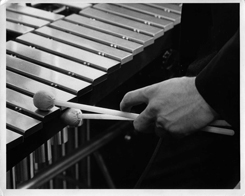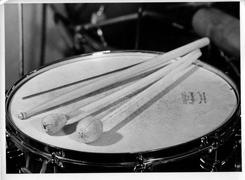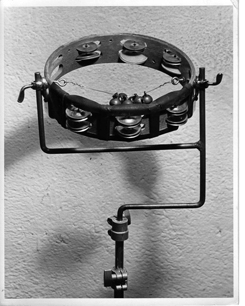1963



I first saw the Zyklus score in January of 1962. At that time I was excited a great deal by several ideas, although they didn't actually form themselves until some time later. The most important of these was this particular superimposition of two concepts of improvisation and composition - the possibility of a performer being able to 'improvise' with fully composed elements within a composed structure. At that time, however, I had no idea of the difficulties involved in realizing this idea.
They began with the problem of 'constructing the instrument', discovering the optimum position for each one of the instruments and finding the means to place them in such positions. Thus they would solidify into one instrument upon which the maximum number of versions of the piece would be possible.
This solidification of the thirteen instruments, which the piece employs, into one is largely something that occurs in the performer's mind; he begins to think of the vibraphone or the drums not as individual instruments but as different areas or 'notes' in the color scale he has available to him. However, there is one physical condition concerning the instrument placement that, I believe, enables the performer to achieve this conception. This is that the movement from any one instrument to any other involves no more than one step. As long as one foot remains in place (in a given passage) the kinesthetic orientation is not lost.
This means that the set-up must be extremely compact - everything compressed on the horizontal plane and expanded on the vertical, at the same time allowing space for all the possible pathways of the stick.
In the case of the drums - which are arranged in a zig-zag pattern instead of in a row, and raised on different levels to allow for rimshots - this compressing not only reduces the overall size of the set-up but allows many groups of notes to be played with one hand.

Most of the instruments in the piece present mounting problems of some sort, either because of the position that they must be placed in or because they are traditionally played unmounted and held in the hand. The cowbells are typical of the problem of mounting a percussion instrument securely (to withstand fortissimo strokes without changing its position) and yet leaving it free enough so as not to be muffled. I found, if the cowbell was fastened to one end of a soft aluminium L-shaped rod by means of a clamp (which was insulated from the bell itself by rubber), that the combined give of rod and rubber was enough to allow the bell to vibrate freely, as well as stop most of the transmission of vibrations to the stand.

With the tam tam and gong the problem of playing a tremolo with one hand was solved simply by reversing them, thus exposing an edge to the performer which can be inserted between two sticks held in one hand. This also allows the use of a padded clamp to muffle the tam tam when there isn't time to do it in the usual manner. I also use this technique of rolling with one hand to solve the problem of the continuous trill on the vibraphone for one page of the score.


I use four different types of sticks in Zyklus - a small steel rod for occasional triangle and cowbell notes, snare drum sticks for passages which center around the drums, and hard and soft beaters. I felt that the hard and soft beaters should meet two requirements; one that they should be the epitome of that type of stick, i. e., the hard to have an extremely high degree of impact sound, and the soft none at all. Two, that they should both be capable of the full range of dynamics. The hard is a nylon stick covered with two layers of leather to keep it from destroying the instruments. (The durability of the nylon seems to lend itself very well to my style of playing.) The soft stick has a medium hard rubber core covered with two layers of felt.

The procuring of an African log drum, at least here in the United States, is a difficult problem. However, there are two substitutes which seem to be very satisfactory. The first of these is a wood drum, which is simply a wooden cylinder with a wooden head glued on one end. I use these, and the only problem I have found was mounting them in a place where they could be played. A second alternative is a smaller drum constructed exactly like the wood drum only made of cardboard. This actually seems to have a sound closer to that of the log drum, but unfortunately it deteriorates very quickly under fortissimo strokes.
Finding instruments with correct pitches is a considerable difficulty, even though the performer can manipulate pitch to a certain extent. For instance, certain cowbells (usually flat ones) can be tuned by bending the lip, although sometimes this tends to deaden the sound. Pitches on the log drums may be lowered by adding tape to the lip. The length of the cylinder of the cardboard and wood drums relates to pitch. With the latter a tunable skin head may be added to the other end. However, it is the sound of the instrument, not the pitch, which is the most important here, or at least as long as no real melodic cliches result.
With the suspended Indian bells and tambourine I found it necessary, in order to have a fortissimo that matched that of the other instruments, to construct a sort of spring cradle for it. This also gave the instrument an after-vibration which I didn't find objectionable.

After an analysis of the new techniques that an improvised version would entail, I found it necessary, in order to learn these techniques and to play the instrument itself, to first compose a fixed version and learn to play it. To give the reader an idea of the notation I have included a photograph of a page of this fixed version showing the point at which I begin. (Illustration lost)
In order to avoid page turns I have glued several pages on one piece of cardboard. It will also be noticed that all the variable elements have been cut out and glued onto the time scale at the places where I chose to play them for this version. This was just my way of notating my decisions.
This article was written for the express purpose of helping other percussionists, who want to learn the piece, to solve some of the practical problems which are involved.